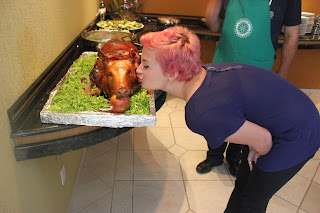On our last morning in Xanxere, we started the day at the Paul Harris school. 690 students attend, ranging in ages from 4-17. First, we met with about 30 teachers, explained the GSE/IGE program, answered some of their questions, and asked some of our own. Interestingly, the students learn about the American Revolution in their history class, as Brazil's independence from Portugal was inspired by our own from Britain. We then sat in on two classes.
 |
| this pre-k class wanted NOTHING to do with us |
After the school, we drove over to the Hile factory that processes and produces tea from the farm we went to yesterday. With flavors like apple, vanilla, and maracuja, this was hands down the best smelling place we've been to yet! :) They have 3 of their own brands, but also produce products for a number of other suppliers under their own labels.
 |
| some of the tea selection |
 |
| yum! Instant vanilla |
 |
| Looking good, team |
 |
| packaging tea bags |
We hurried through the tea tour fairly quickly because we were expected in the next city by lunch, so we piled into the SUV and van (no more cars for us - with all our luggage, we no longer fit!) and headed 45 minutes to Chapeco. It's hard to believe we've already seen 16 cities in Santa Catarina, and this will be our last.
 |
| Xanxere, the town of big corn |
Lunch was cosumed quickly, and we were off to GAPA (Grupo de Apoio de Prevencao a AIDS), a 24 year old NGO whose main purpose is to prevent and slow down the spread of AIDS, tuberculosis, and hepatitis. They are focused on education to women, adults 20-35, and the poor population, although they also do outreach to children and seniors In Brazil, 98% of the people know about the disease, but only 42% use condoms. In addition to education, GAPA provides a staff psychologist who works with those infected, and also focuses on the state and government to provide community resources (proper treatment and hospitals). They are run by about 30 volunteers, but they still battle significant misconceptions which harm their ability to do more; some think the disease is contagious by touching or being around, others think it's no longer a serious problem because we hear about cures and deaths have decreased dramatically. Therefore, GAPA is also working to eliminate the stigmas associated with AIDS, which will help to bring both volunteers and participants into the program. Although they are small, I was very impressed with their sophisticated strategy and marketing plans.
 |
| some of GAPA's marketing materials, including local artist designed condom packages for discrete carrying around |
 |
| GAPA's executive director, show off the condoms |
We then said "tchau" to GAPA and "ola" to Verde Vida, another NGO in Chapeco that is aligned with the local rotary group. Verde Vida attracts at-risk teens in a heavily crime ridden area by providing education and social support, and a place to go to get off the streets. We visisted the computer lab, where the kids learn how to build and work with computers, the library, and walked past a room with a few chess boards set up. In addition to these social activities, there are 20 courses offered to help train these children for a job. I think the kids were very surprised when we dropped in on the future beauticians! Then the taekwondo class and circus class both put on a show for us, which was really neat. The program is fully supported and sustained by a for-profit recycling cooperative with 64 employees that is attached to the building.
 |
| computer lab in Verde Vida |
 |
| beauty school dropout, go back to high school |
 |
| taekwondo takedown |
8
 |
| circus course |
With a few hour of downtime and dinner with our host families in our bellies, we boarded the bus and started the approx 10 hour drive to Foz de Iguazu. Buckle up!



















































